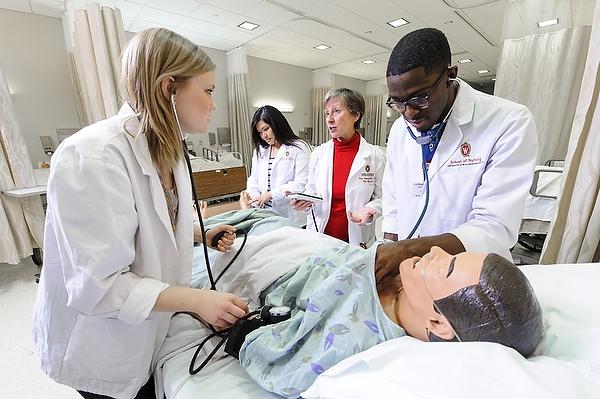With simulators to emulate the environment of a clinical setting, University of Wisconsin School of Nursing incorporates technology in their teaching to better prepares students for realities of the medical field.
After their move from the clinical sciences center in 2004, School of Nursing clinical instructor Paula Jarzemsky said the school has been able to introduce more simulation. While the use of simulation is a constant in nursing programs across the country, the technology’s presence is beneficial in helping bridge the gap between training and the real world.
UW nursing clinical instructor Paula Woywod said the School of Nursing tries to make sure students are prepared for handling situations in the real world.
“There can be different goals [in simulation] depending on what you’re trying to achieve, but overall we do try to make the transition into clinical practice a little bit smoother and easier,” Woywod said.
Simulation occurs in the Center for Technology Enhanced Nursing, also known as C10. Jarzemsky said this space is fully equipped with a four-bed hospital suite, nursing station, a medical room and two debrief rooms.
Students also use an apartment style area to stage home visits, plus a six-room clinic where students can practice their interviewing skills. Jarzemsky said School of Nursing dean Katharyn May’s goal in building the simulation was to represent the continuum of health care. As a result, the program has made significant investments into clinical simulation.
Woywod said collaboration is encouraged in the School of Nursing. In certain simulations, nursing students work with occupational therapists and students of other disciplines such as the School of Pharmacy. But teamwork is not only emphasized across disciplines, but within groups of students working through scenarios in simulation as they problem-solve.
“I think the lesson sticks with them better than a pen and paper case study or a PowerPoint presentation with straight facts,” Jarzemsky said. “As much as we’re able to recreate what they will encounter in real life, they’re going to be that much further along in terms of not having surprises in the clinical setting.”
There are times when mistakes are made, and students are discouraged as a result. But Jarzemsky said if there’s any place where mistakes should happen, it’s C10. Being a low-risk learning environment, C10 offers students the space to take what they’ve learned in their instructional labs one step further.
Woywod said instructors approach this type of learning as an opportunity. It’s a safe environment, but students must come prepared, having reviewed the case information of the scenario they will experience. But as the scenario progresses, students make observations on how the events unfold and have discussion with the instructors about their performance in regard to what went well and areas that may need improvement.
Jarzemsky said it’s important to have happy learners, and students enjoy learning in the simulation environment because it’s fun.
“We’re basically immersing them in a situation that some instructor has dreamed up and decided was a great learning experience,” Jarzemsky said. “So it’s a great way to show what you know and discover what you don’t know.”


